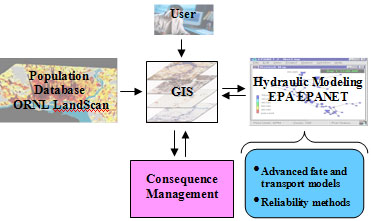Overview: Water utilities are responsible for constructing, operating, and maintaining water distribution systems. Adequacies of such systems are normally measured in terms of the ability of the system to provide sufficient flows at adequate pressures to meet existing and predicted demands. System reliability is typically employed as the primary objective in water system design, while most optimization models focus on least cost as the principal objective. Both system reliability and system optimization are important objectives and the key to successful  design lies in effectively maximizing reliability while minimizing cost.
design lies in effectively maximizing reliability while minimizing cost.
Water utilities are also facing new responsibilities. Their mission has now expanded beyond delivery of a dependable and safe drinking water supply to include security and counter-terrorism measures. In the Public Health Security and Bioterrorism Preparedness and Response (BPR) Act of 2002, the need for drinking water systems to undertake a more comprehensive view of water safety and security is addressed. The BPR Act, which amends the Safe Drinking Water Act, specifies actions water systems and the U.S. Environmental Protection Agency (EPA) must take to improve the security of the nation's drinking water infrastructure.
Application: Our research goal is to develop a comprehensive vulnerability assessment tool to incorporate analysis of physical and chemical/biological threats while addressing societal and economical concerns adverse events. We hypothesize that the incorporation of reliability methods, advanced fate and transport models, geographic information systems (GIS), and consequence management strategies within a vulnerability assessment tool will aid water utilities in better understanding the risks and vulnerabilities associated with their water distribution networks and enable them to manage and mitigate any adverse events. Use of improved fate and transport models coupled with advanced reliability methods provide an opportunity to increase the ability to track the fate and transport of contaminants in the network. Employment of these additional tools will assist the U.S. EPA's efforts to improve the reliability and security of water distribution systems.